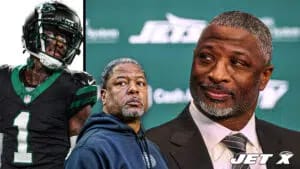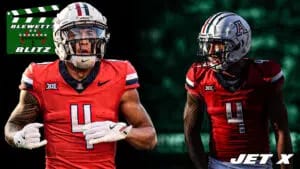Zack Kuntz is as good an athlete as any prospect in the 2023 draft class. So why did he last until the seventh round?
With their seventh and final selection in the 2023 NFL draft (landing at No. 220 overall in the seventh round), the New York Jets selected Old Dominion tight end Zack Kuntz.
Kuntz is notorious for his perfect Relative Athletic Score (RAS) of 10.00. Purely based on testing results, he is one of the most gifted athletes to ever play the tight end position. This has Jets fans believing Kuntz could be a potential steal out of the seventh round.
Despite his world-class athleticism, Kuntz fell all the way into the seventh round. Why did this happen?
To learn more about Kuntz as a player, let’s dive into his analytical profile. We’ll analyze his strengths, weaknesses, role, usage, and much more to figure out why Kuntz fell and deduce exactly how much development Kuntz needs to fulfill the potential bestowed by his natural physical gifts.
Jets 2023 draft class analytical profiles:
- EDGE Will McDonald
- C Joe Tippmann
- OT Carter Warren
- RB Israel Abanikanda
- LB Zaire Barnes
- CB Jarrick Bernard-Converse
Measurables/athleticism
Kuntz lit up the NFL Scouting Combine. Here is a look at Kuntz’s measurements and drill performances from the combine, and where they rank all-time among tight end prospects according to Relative Athletic Score (a 0-to-10 scale representing percentile ranking; i.e. a 6.00 RAS is equal to the 60th percentile):

Kuntz is the fourth tight end prospect in RAS history (since 1986) to post a perfect score of 10.00, joining Virginia’s Jelani Woods (R3, Colts, 2022), USC’s Jordan Cameron (R4, Browns, 2011), and a familiar name for Jets fans: West Virginia’s Anthony Becht (R1, Jets, 2000).
Among prospects who were selected in the 2023 draft, Kuntz was one of three players with a 10.00 RAS, joining Florida QB Anthony Richardson (R1, Colts) and Maryland CB Deonte Banks (R1, Giants).
The well-roundedness of Kuntz’s athletic profile is astounding, especially when considering his unusual height at 6’7⅜”. He posted a RAS above 9.50 in the 40-yard dash (4.55), vertical jump (40″), broad jump (128″), shuttle (4.12), and three-cone (6.87).
Role/usage
Old Dominion did not utilize Kuntz in a traditional fashion. He was almost a quasi-receiver.
Over his two years at Old Dominion, Kuntz lined up in the slot on 44.5% of his offensive snaps. This split leaned even heavier toward the slot on passing plays. Kuntz lined up in the slot for 60.5% of his routes.
Kuntz lined up as an in-line tight end on just 45.9% of his offensive snaps and 27.4% of his routes.
Receiving production is mostly poor
The reason Kuntz fell to the seventh round despite his athleticism is simple: He hasn’t shown that he can translate his physical tools to the football field.
Over five years in college (2018-20 at Penn State, 2021-22 at Old Dominion), Kuntz only grabbed 88 passes for 862 yards and seven touchdowns – and most of that production came as an older player facing weak competition. Throughout his three years at Penn State, Kuntz only had three catches. It wasn’t until he transferred to a weaker conference that he started to produce, and at that point, he was already 22 years old. Kuntz will be 24 this June.
Kuntz’s lone season of notable production came in 2021 – and to be fair, the numbers were highly impressive on the surface. Kuntz tied for second among FBS tight ends with 73 receptions. He also ranked ninth in receiving yards (692) and 19th in touchdowns (5).
The sheer volume of Kuntz’s 2021 season is impressive, but his efficiency in that season is a red flag. Was he actually an effective target or did he just get peppered with an exorbitant number of targets on a 6-7 Conference USA team? It’s a question worth asking, as Kuntz’s 112 targets were second-most among FBS tight ends and 17 more than the third-ranked player.
Efficiency-wise, Kuntz was not effective in 2021. Among the 69 FBS tight ends with at least 30 targets, Kuntz ranked 59th in yards per reception (9.5), 45th in catch rate (65.2%), 29th in drop rate (5.2%), and 63rd in passer rating when targeted (78.4). Most concerning was Kuntz’s performance in specific areas where his uber-athleticism should have allowed him to dominate: He was 41st in contested-catch rate (44.4%) and 60th in YAC per reception (3.6).
In 2022, Kuntz only played five games before a dislocated knee cap ended his season. Prior to the season-ending injury, Kuntz’s involvement in Old Dominion’s passing game had been severely diminished. Kuntz finished with 12 catches for 144 yards and two touchdowns. That’s 2.4 catches for 28.8 yards per game, a far cry from his 5.6 catches for 53.2 yards in 2021.
Even more concerning was Kuntz’s further decline in efficiency. While he pumped his yards-per-reception rate up to 12.0, his catch rate declined to an abysmal 42.9% (12 catches on 28 targets). It was the second-worst catch rate among FBS tight ends with at least 25 targets. Furthermore, Kuntz’s YAC per reception remained mediocre at 3.8 while his contested-catch rate dropped even further to 33.3%.
Blocking is similarly poor
Kuntz’s blocking production is equally as concerning as his receiving production, if not more so.
PFF scored Kuntz with a run-blocking grade of 60.7 in 2021. That ranked 87th out of 159 FBS tight ends with at least 200 run-blocking snaps, putting Kuntz at the 46th percentile. This was as a 22-year-old facing weak competition at Old Dominion – despite having off-the-charts physical traits that should have allowed him to dominate. Kuntz’s mediocre performance despite all of those advantages is a sign that his blocking technique is extremely poor.
Old Dominion showed a lack of faith in Kuntz’s blocking by greatly reducing his role in the run game. He dropped from 314 run-blocking snaps in 2022 (24.2 per game) to 75 run-blocking snaps in 2021 (15.0 per game), a decline of over nine run-blocking snaps per game. Percentage-wise, Kuntz run-blocked on 47.4% of his offensive snaps in 2021 and only 36.2% of his offensive snaps in 2022.
When a college team reduces a player’s role as he enters his fifth season, that tells you everything you need to know. Fifth-year players should be leading their teams. Old Dominion was phasing Kuntz out of the offense rather than expanding his role. They watched him in practice every day and know more about him than anyone on the outside, so it’s a red flag that they believed it was best for the team to reduce his role as both a receiver and a blocker.
Zack Kuntz is an enormous project
Fans typically get excited when their team uses a late selection on a player with elite athletic-testing numbers. And it’s understandable.
Picks at this point of the draft are not expected to work out anyway, so if your team drafts a guy like Kuntz who has quantifiable elite-level traits attached to his name (as opposed to non-quantifiable traits like instincts or technique), it’s tantalizing. You can point directly to his testing numbers as a legitimate reason to believe he has a high ceiling if things work out, which you couldn’t do with a late-round pick who does not have elite testing numbers.
However, the opposite perspective is equally important but rarely considered.
We know teams love to draft gifted athletes – hence the fact that most of the players who get drafted early have top-end testing numbers. So, if a guy has elite-level testing numbers and still gets passed over until the seventh round, shouldn’t we be concerned that he must have massive red flags in other areas?
This is the case with Kuntz. On one hand, it’s fair to be excited about getting such a special athlete with a seventh-round pick. On the other hand, he’s available in the seventh round for a reason. He simply was not a very good player in college. And considering he’s already 24 years old and was playing at Old Dominion, there is serious doubt as to whether he will ever become a capable player in the NFL.
The odds of Kuntz working out for the Jets seem to be incredibly low. He has a long, long way to go as a football player. His testing numbers alone got him drafted. With slightly less impressive testing numbers, he certainly would have gone undrafted.








